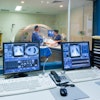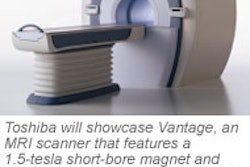The combination of 4-tesla MRI with spectroscopy could offer an accurate and noninvasive method of diagnosing breast cancer, University of Minnesota researchers report in the online issue of Magnetic Resonance in Medicine (Nov. 21, 2003).
"In this paper we report on the development of a breakthrough method for quantifying the choline compounds in breast lesions," wrote lead investigator Michael Garwood, Ph.D., professor of radiology at the University of Minnesota Medical School and a researcher at its Cancer Center, both in Minneapolis.
"Choline is present in normal tissue, but proliferating choline is typical of malignant tissue. So we needed a way not only to spot choline in tissue, which can be done with 1.5-tesla MRI, but to quantify the proliferation of choline and thereby identify the presence of a malignancy. The news here is that we are now able not only to spot choline in breast tissue but also to measure it," he told AuntMinnie.com.
Quantification of metabolite levels is routine in MR spectroscopy (MRS) of the brain, but it is more difficult to perform on the breast due to heterogeneous distribution of glandular and adipose tissues. The researchers used water as an internal reference compound to account for partial volumes of adipose tissue. They estimated peak amplitudes by "fitting one peak at a time over a narrow frequency band to allow measurement of small metabolite resonances in spectra with large lipid peaks," thereby accounting for variable sensitivity of breast tissue to the 4-tesla spectroscopy.
"Using this technique, a tCho (choline) peak could be detected and quantified in 214 of 500 in vivo spectra," they reported. "Levels of tCho were found to be significantly higher in malignancies than in benign abnormalities and normal breast tissues, suggesting that this technique could be used for diagnosing suspicious lesions and monitoring response to cancer treatments."
Garwood explained that tCho concentrations were much higher in malignancies than in benign lumps and normal breast tissues. Investigators enrolled 104 subjects in the first arm of the study. In the next arm, they will measure diagnostic results of this new spectroscopic technique against the results of follow-up biopsy; in order to determine the accuracy of the test, tCho concentrations will be compared with the pathologic findings in excised tissues.
"Using high magnetic fields and this spectroscopic technique may produce a powerful way to diagnose breast cancer and to monitor its response to treatment. It will not replace biopsy since oncologists need information about receptor levels. But we hope that this technique will eventually be used to avoid unnecessary biopsy, as when an MRI is inconclusive but the choline is very low, " Garwood said.The ongoing three-year study, sponsored by the National Institutes of Health, remains open to women who have a suspicious breast lump; however, MRI and MRS must occur before a biopsy or surgery on the lump has been performed. Physicians and women interested in more information about the study should call 612-273-1944.
By Bruce SylvesterAuntMinnie.com contributing writer
November 25, 2003
Related Reading
MRI, MRS piece together neurological damage in chemical solvent abusers, November 20, 2003
PET proves versatile in imaging gynecologic cancer, August 4, 2003
MR spectroscopy again links choline to carcinoma, October 9, 2002
MR spectroscopy of biopsy specimen could spare breast surgery, October 1, 2002
Copyright © 2003 AuntMinnie.com



.fFmgij6Hin.png?auto=compress%2Cformat&fit=crop&h=100&q=70&w=100)




.fFmgij6Hin.png?auto=compress%2Cformat&fit=crop&h=167&q=70&w=250)











